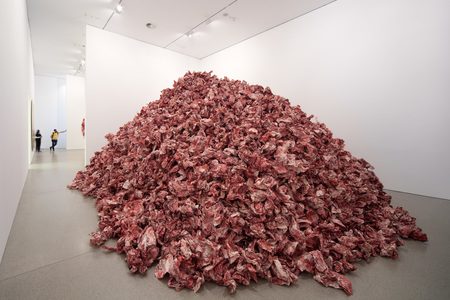Imran Qureshi – IKON gallery: Review
This winter, Birmingham’s IKON Gallery opens its doors for Pakistani artist Imran Qureshi, and his most extensive exhibition to date in the UK. Winner of the 2013 Deutsche Bank’s “Artist of the Year”, there was no doubt that his works, both old and newly made for IKON would prove to be a success and incite much needed discussion of Pakistan’s current affairs. With both fragile miniature paintings and larger scale site-specific installations, Qureshi ensures that whatever the taste of his audience, no-one is left disenchanted.
One of Pakistan’s most important artists to date, Qureshi intertwines the traditional practice of miniature painting whilst providing a highly politicized discourse of Pakistan’s current tumultuous climate. His ability to reclaim an age old tradition that blossomed in the Mughal courts of the late sixteenth century and make it relevant to current issues of today is striking – as are his unique works. Being able to appeal not only in terms of content but through sheer aesthetic intricacy, the attention to detail in each of his works astonishes, with the human eye only just able to capture every crease, crinkle and ornamental leaf. Through a multitude of mediums, his works both simultaneously conceal and overtly display connotations of bloodshed, either providing violent imagery instantly or perhaps even more haunting- when discovered as a secondary realisation.
Upon first inspection, Qureshi’s array of miniature paintings seems to depict an idyllic world of nature, with light watercolour scenes wondrously infused with gold leaf. The paradise like quality of his work brings to mind the spirituality of Muslim faith, where a traditional, peaceful world presides that of the modern turmoil we associate with Pakistani culture today.However, Qureshi is far from optimistic in his world view, and infuses splatters of sharp red, as seen in Blessings upon the Land of my Love (2011) and Opening Word of this New Scripture (2013) to express the devastating intrusion violence has within the confines of religion. Gone is the fragile delicacy of blades of grass and ornamental leaves, replaced instead with the continuous overwhelming threat of bloodshed. The symbolism of blood and its continuous presence in Qureshi’s work became prevalent after he was affected by a terrorist attack in a busy market place in Pakistan in 2010.
The subtlety in Qureshi’s projection of his message is reiterated in his installation And they still seek the traces of blood (2013). An invasion of thousands of crumpled sheets of paper (comprising of printed images from his earlier works) form a monumental heap that assaults the senses as we are unable to decipher the context in which this impressive sculpture looms over us. If, like me, you had not known that the title quotes a poem by Faiz Ahmed Faiz, telling of the dishonourable and often questionable deaths of innocent civilians, the installation would seem rather frivolous in its stature. Nonetheless with this knowledge, Qureshi yet again maintains a humanistic and politically conscious narrative, bringing to light the vast injustice and infringement relentlessly made on human life.
The unity of ornamental flowers and blood in Qureshi’s works simultaneously disturb and fascinate as we are almost disgusted in our appreciation of their beauty, echoed by the artist himself in an interview in 2011, “there is an almost paradoxical quality between violence and beauty, life and death existing on one surface.” In I want you to stay with me (2013), dark maroon pools seep across the gallery floor evoking the bloody aftermath of a terrorist attack, yet each splatter of blood is intertwined with elegant hand painted flowers. Bloody impressions of the artist’s feet in This Leprous Brightness (2010–2011) provide perhaps the most distressing imagery even whilst considering the adornment of blossoms. The stark minimalistic quality is void of the façade of gold leaf present within In They Shimmer Still (2012) where Qureshi uses large oval canvases to portray the running blood-blossom motif rather adhering to conventional artistry.
Ultimately, Qureshi’s works despite their undeniable beauty always tell a darker story. Yet through the infusion of blossoms we are offered the possibility of regeneration and hope for Pakistan even amidst such death and destruction.
This exhibition will be at the IKON Gallery, Birmingham until the 25 January 2015.

Comments